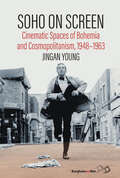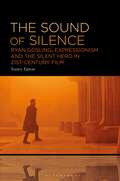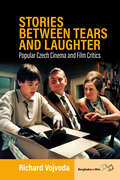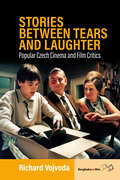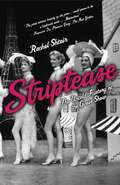- Table View
- List View
The Silence of the Lambs (Devil's Advocates)
by Barry ForshawThe 1991 film The Silence of the Lambs, based on Thomas Harris's bestseller, was a game-changer in the fields of both horror and crime cinema. FBI trainee Clarice Starling was a new kind of heroine, vulnerable, intuitive, and in a deeply unhealthy relationship with her monstrous helper/opponent, the serial killer Hannibal Lecter. Jonathan Demme's film skillfully appropriated the tropes of police procedural, gothic melodrama and contemporary horror and produced something entirely new. The resulting film was both critically acclaimed and massively popular, and went on to have an enormous influence on 1990s genre cinema. Crime and horror authority Barry Forshaw closely examines the factors that contributed to the film's impact, including the revelatory performances of Jodie Foster and Anthony Hopkins in the lead roles.
Snuff (Devil's Advocates)
by Mark McKennaSnuff (1976) occupies a unique place in cinematic history, as the first commercially successful film to capitalise upon the myth of the ‘snuff’ movie. By blending cinema verité styling with a media moral panic, savvy producer Allan Shackleton’s blending of a long-forgotten exploitation film with a newly filmed bloody, if unconvincing conclusion, only served to consolidate the belief that somewhere, at some time, someone was killed on camera in an attack that was as much about the sexual gratification of the film’s intended audience, as it was about the commercial rewards for those producing the film. In the years since its release, the film has been routinely cited as ‘evidence’ of the snuff movie’s existence, contributing to a cultural history that exists outside of the film. This book explores the production, distribution and exhibition of the film Snuff, alongside that cultural history, considering how a scarcely seen exploitation film contributed to a popular understanding of the snuff movie. It assesses the cultural, cinematic and political legacy of the film and asks whether the established definition of what might constitute a snuff movie, that was defined 45 years ago, is sufficient in an attention economy that is based upon participatory culture.
The Social Architecture of French Cinema: 1929–1939 (Contemporary French and Francophone Cultures #34)
by Margaret FlinnFrom the fleetingly captured street scenes of the city symphony, to the meticulously reconstructed studio city of musical comedies; from the propagandistic Popular Front documentaries about construction workers, to poetic realism’s bittersweet portraits of populist neighborhoods: Social Architecture explores the construction, representation and experience of spaces and places in documentary and realist films of the French 1930s. In this book, Margaret C. Flinn tracks the relation between the emergent techniques of French sound cinema and its thematic, social and political preoccupations through analysis of discourse in contemporary press, theoretical texts and through readings of films themselves. New light is shed on works of canonical directors such as Renoir, Clair, Vigo and Duvivier by their consideration in relationship to little known documentary films of the era. Flinn argues that film has a readable architecture—a configuration of narrative and representations that informs, explains, and creates social identities, while reflecting upon the position of individuals within their societies.
Soho on Screen: Cinematic Spaces of Bohemia and Cosmopolitanism, 1948-1963
by Jingan YoungDespite Soho’s rich cultural history, there remains an absence of work on the depiction of the popular neighbourhood in film. Soho on Screen provides one of the first studies of Soho within postwar British cinema. Drawing upon historical, cultural and urban studies of the area, this book explores twelve films and theatrically released documentaries from a filmography of over one hundred Soho set productions. While predominantly focusing on low-budget, exploitation films which are exemplars of British and international filmmaking, Young also offers new readings of star and director biographies, from Laurence Harvey to Emeric Pressburger, and in so doing enlivens discussion on filmmaking in a time and place of intense social transformation, technological innovation and growing permissiveness.
The Sound of Silence: Ryan Gosling, Expressionism and the Silent Hero in 21st-Century Film
by Nancy EptonThe Sound of Silence explores how non-verbal communication in film, shown primarily through the acting of Ryan Gosling, provides an expressive space in which passive audience viewing is made more active by removing the expository signifier of dialogue. The German Expressionist era may have been brief, but the shadows cast since its end nonetheless loom large. The silhouetted, cigar-wielding men of film noir and their respectively dark, doom-laden haunts mirror the angst-inducing atmospheres of their forebearers, while also introducing the now-familiar figure of the silent hero. Considering the numerous silent hero actors in film history, there's one that stands out in the 21st century like no other: Ryan Gosling. His later career has seen some of the most iconic silent heroes of the past decade, with films such as Drive, Only God Forgives, Blade Runner 2049 and First Man cementing him as the go-to guy for a monosyllabic, taciturn and moody hero whose actions speak louder than words. This book argues that it is Gosling's expressive capabilities that keep audiences compelled by his performances. With the use of non-verbal silence – combined with its counterbalance, sound – a more active, emotive audience response can be achieved. Looking further into this idea through theorists such as Michel Chion and Susan Sontag, the book demonstrates that the sound of silence is one of the most meaningful cinematic sounds of all.
Stories between Tears and Laughter: Popular Czech Cinema and Film Critics
by Richard VojvodaWhile histories of Czech cinema often highlight the quality of Czechoslovak New Wave films made in the 1960s, post-socialist Czech cinema receives little attention. Through a methodology of historical reception, Stories between Tears and Laughter explores how attitudes towards post-socialist Czech cinema have shifted from viewing it as radical “art cinema” and more towards popular cinema. By analyzing publicity materials, reviews, and articles, Richard Vojvoda offers a new perspective on the notions of cultural value and quality that have been shaping the history of post-socialist Czech cinema.
Stories between Tears and Laughter: Popular Czech Cinema and Film Critics
by Richard VojvodaWhile histories of Czech cinema often highlight the quality of Czechoslovak New Wave films made in the 1960s, post-socialist Czech cinema receives little attention. Through a methodology of historical reception, Stories between Tears and Laughter explores how attitudes towards post-socialist Czech cinema have shifted from viewing it as radical “art cinema” and more towards popular cinema. By analyzing publicity materials, reviews, and articles, Richard Vojvoda offers a new perspective on the notions of cultural value and quality that have been shaping the history of post-socialist Czech cinema.
Studying City of God (Studying Films)
by Stephanie MuirA leading example of a resurgent Latin American cinema – 'la buena onda' – in the early twenty-first century, City of God was a huge international popular and critical success. A combination of intoxicating, Hollywood-style genre film-making and hard-hitting, social-realist subject matter it was hailed as a masterpiece at Cannes in 2002 and seen by over 3 million people in Brazil, including the Brazilian cabinet. In Studying City of God, Stephanie Muir considers: The historical and industrial context of City of God – a brief history of Latin American cinema is followed by a more detailed account of film-making in Brazil – from light-hearted travelogues to Cinema Novo and after – all in the context of increasing globalisation; Narrative and Genre – how the film uses the components of narrative in a complex way, ex-perimentally manipulating time while using traditional genre conventions that are highly recognisable to mainstream audiences; Film language – the formal elements of the film are dissected through a detailed illustrated analysis of the kinetic, scene setting opening sequence; Audience responses – from establishment critical reaction to fan-based Internet sites and student feedback; Representation and Ideology – just how 'authentic' can a film such as City of God hope to be? Does its style overwhelm its subject matter?
Studying Early and Silent Cinema (Auteur)
by Keith WithallIn this accessible introduction to early and silent cinema, which is currently enjoying a renaissance, both academically and in the popular imagination thanks to The Artist, Keith Withall provides both a comprehensive chronology of the period until the birth of sound and also a series of detailed case studies on the key films from the period – some well known (including Griffith's The Birth of a Nation, Eisenstein's Strike and Chaplin's The Kid), some perhaps less well familiar (including Murnau's The Last Laugh and Oscar Micheaux's Within Our Gates). As well as covering in detail the major film-making figures and nations of the period, the author also provides insights into the industry in less well documented areas. Throughout, the films and film-makers are placed in the context of rapid worldwide industrial change. (Please note this book is a revised and expanded version of Early and Silent Cinema: A Teacher's Guide, published by Auteur in 2007.)
Studying Feminist Film Theory (Auteur)
by Terri MurrayThis book is aimed at helping media and film studies teachers introduce the basics of feminist film theory. No prior knowledge of feminist theory is required, the intended readers being university undergraduate teachers and students of film and media studies. Areas of emphasis include spectatorship, narrative, and ideology. Many illustrative case studies from popular cinema are used to offer students an opportunity to consider the connotations of visual and aural elements of film, narrative conflicts and oppositions, the implications of spectator “positioning” and viewer identification, and an ideological critical approach to film. Explanations of key terminology are included, along with classroom exercises and practice questions. Each chapter begins with key definitions and explanations of the concepts to be studied, including some historical background where relevant. Case studies include film noir, Kathryn Bigelow’s Strange Days and the work of directors Spike Lee, Claire Denis, and Paul Verhoeven.Studying Feminist Film Theory is a revised and expanded version of Feminist Film Studies: A Teacher’s Guide, published by Auteur in 2007.
Studying Fight Club (Studying Films)
by Mark RameyFight Club is, on one level, pop-culture phenomena and on another, a deeply philosophical and satirical exploration of modern life. David Fincher's 1999 film (and Chuck Palahniuk's source novel) has had a huge impact on audiences worldwide leading to spoofs, homage, merchandising and numerous Internet fan sites. On initial release the film was met with wide hostility from critics who either failed to appreciate its satirical intent or believed the film failed to deliver on its satirical promise. Early in its DVD afterlife, however, a wider audience began to appreciate the film's significance and radical message. Although attracted by the film's playfulness and star wattage, however, many students struggle with its theoretical notions such as Capitalism, materialism, anarchy and so on. This is one film, which therefore merits a thoughtful and provocative analysis but also an accessible one, and Mark Ramey has provided just that.
Studying French Cinema (Auteur)
by Isabelle VanderscheldenTaking a text-led approach, with the emphasis on more recent popular films, Studying French Cinema is directed at non-specialists such as students of French, Film Studies, and the general reader with an interest in post-war French cinema. Each of the chapters focuses on one or more key films from the ground-breaking films of the nouvelle vague (Les 400 coups, 1959) to contemporary documentary (Etre et avoir, 2002) and puts them into their relevant contexts. Depending on the individual film, these include explorations of childhood, adolescence and coming of age (Les 400 coups, L'Argent de poche); auteur ideology and individual style (the films of Jean-Luc Godard and Agnes Varda); the representation of recent French history (Lacombe Lucien and Au revoir les enfants); transnational production practices (Le Pacte des loups); and popular cinema, comedy and gender issues (e.g. Le Diner de cons). Each film is embedded in its cultural and political context. Together, the historical discussions provide an overview of post-war French history to the present. Useful suggestions are made as to studies of related films, both those discussed within the book and outside.
Studying Hammer Horror (Studying Films)
by Victoria WaldenWhen Hammer Productions was formed in the 1920s, no one foresaw the impact this small, independent studio would have on the international film market. Christopher Lee's mesmerizing, animalistic, yet gentlemanly performance as Dracula, Frankenstein's Monster, and the Mummy were celebrated worldwide, and the Byronic qualities of Peter Cushing's Dr. Frankenstein, among his many other Hammer characters, proved impossible to forget. Hammer maintained consistent period settings, creating a timeless and enchanting aesthetic.Studying Hammer Horror treats Hammer as a quintessentially British product and through a study of its work investigates larger conceptions of national horror cinemas. The book examines genre, auteur theory, stardom, and representation within case studies of Curse of Frankenstein (1957), Twins of Evil (1971), and Hammer's latest film, Beyond the Rave (2008). Walden weighs Hammer's impact on the British film industry, past and present. Intended for students, fans, and general readers, this book transcends superficial preconceptions of Hammer horror in order to reach the essence of Hammer.
Studying Horror Cinema (Auteur)
by Bryan TurnockAimed at teachers and students new to the subject, Studying Horror Cinema is a comprehensive survey of the genre from silent cinema to its twenty-first century resurgence. Structured as a series of thirteen case studies of easily accessible films, it covers the historical, production, and cultural context of each film, together with detailed textual analysis of key sequences. Sitting alongside such acknowledged classics as Psycho and Rosemary’s Baby are analyses of influential non-English language films as Kwaidan, Bay of Blood, and Let the Right One In. The author concludes with a chapter on 2017’s blockbuster It, the most financially successful horror film of all time, making Studying Horror Cinema the most up-to-date overview of the genre available.
Studying The Hurt Locker (Studying Films)
by Terence McSweeneyIn this vibrant and dynamic book-length study drawing on a broad tapestry of research, Terence McSweeney offers an exploration of The Hurt Locker (2009), its stylistic and narrative devices, its cultural impact, its reception, and its relationship to the genre of the war film. McSweeney places the film in a richly textured historical, political, and industrial context, arguing that The Hurt Locker is part of a long tradition of films about American wars that play a considerable role in how audiences come to understand the conflicts that they depict. Thus, films about a nation’s wars are never “only a movie” but rather should be considered a cultural battleground themselves on which a war of representation is waged.
Studying Ida (Studying Films)
by Sheila SkaffPaweł Pawlikowski’s 2013 film Ida was exceptionally warmly received in the United States, culminating in the Academy Award for Film Not in the English Language, but it was not without controversy. Sheila Skaff’s introduction to the film explains the historical setting, including the violence that took place in the Polish countryside during World War II and was not exposed for sixty years, and provides political and cultural analysis to aid the reader in understanding the film’s setting and narrative. Skaff also touches on the influence of the film on current events in Poland, where censorship of it by an increasingly nationalist government has polarized the country. It also situates Ida within the contexts of Polish and world film history. Scene-by-scene analysis is accompanied in each chapter by background information that gives context to the aesthetic and narrative choices made by the director.
Studying The Lord of the Rings (Studying Films)
by Anna DawsonUnquestionably the first cinematic phenomenon of the twenty-first century, Peter Jackson's trilogy was a project of enormous artistic vision and financial risk. It is also a rich text for those studying film and media, perhaps for the first time. Studying The Lord of the Rings is the first book to consider the films in these terms, looking in turn at each of the major concepts: their complex origins and narrative structure; issues of representation masculinity, femininity and race; their generic patterns (to which genre do the films belong?) and thematic concerns; their industrial context from theatrical release to DVD extended editions; film language fusing classical mise-en-scène with cutting-edge technological practice. The aim throughout is to highlight critical debates and key terms, to relate these to the texts and to explore their stylistic and cultural impact. This Student Edition (a previously published Instructor's Edition is available) brings the story up to date with reflections on The Hobbit films.
Studying Shakespeare on Film (Studying Films)
by Rebekah OwensAimed at newcomers to literature and film, this book is a guide for the analysis of Shakespeare on film. Starting with an introduction to the main challenge faced by any director—the early-modern language—there follows exemplars for examining how that challenge is met using as case studies twelve films most often used in classroom teaching, including Romeo and Juliet, Macbeth, and The Tempest.The first chapter explores how a director can tell the story in a setting that embraces the expectations of realism in cinema, but still pays homage to the theatrical origins of the work. The second chapter discusses films in which the setting provides a visual analogy with the preoccupations of the story, but not at the expense of Shakespeare's language. The third chapter extends this to show how some films use recent history as a setting, adding a further layer of meaning to the story from the cultural resonances associated with that historical past. These films also rely on an assumption that Shakespeare is so well-known as to form a distinctive, easily recognized brand in the cinema marketplace. Thus, his work can be reimagined in completely different genres such as those films that are the subject of the final chapter.
Studying Talk to Her (Studying Films)
by Emily HughesTalk to Her (2002) is a hugely rich and interesting though ambiguous film that met with both popular success and critical acclaim. The film won an Oscar for best original screenplay and has been hailed by some critics as Pedro Almodóvar's masterpiece. Yet like most of Almodóvar's films, little is clear cut. The characters are complex and our affinity and empathy for them shifts throughout the film. In Studying Talk to Her, Emily Hughes provides an in-depth analysis of both the formal elements of the film (its narrative, genre, and auteur study) and the themes and issues it raises, discussing the social context of modern Spain and its old, traditional iconography; shifting attitudes towards gender; and, crucially, the film's uneasy, morally ambiguous depiction of rape and the spectator's reaction to it.
Studying the British Crime Film (Studying British Cinema)
by Paul ElliottEver since its inception, British cinema has been obsessed with crime and the criminal. One of the first narrative films to be produced in Britain, the Hepworth's 1905 short Rescued by Rover, was a fast-paced, quick-edited tale of abduction and kidnap, and the first British sound film, Alfred Hitchcock's Blackmail (1930), centered on murder and criminal guilt. For a genre seemingly so important to the British cinematic character, there is little direct theoretical or historical work focused on it. The Britain of British cinema is often written about in terms of national history, ethnic diversity, or cultural tradition, yet very rarely in terms of its criminal tendencies and dark underbelly. This volume assumes that, to know how British cinema truly works, it is necessary to pull back the veneer of the costume piece, the historical drama, and the rom-com and glimpse at what is underneath. For every Brief Encounter (1945) there is a Brighton Rock (2010), for every Notting Hill (1999) there is a Long Good Friday (1980).
Studying Waltz with Bashir (Studying Films)
by Giulia MillerOn its release in 2008, Ari Folman's animated documentary Waltz with Bashir was heralded as a brilliant and original exploration of trauma, and trauma's impact on memory and the recording of history. But it is surprising that although the film is seen through the eyes of one particular soldier, a viewpoint portrayed using highly experimental forms of animation, this has not prevented Waltz with Bashir from being regarded as both an "autobiographical" and "honest" account of the director's own experiences in the 1982 Lebanon war. In fact, the film won several documentary awards, and even those critics focusing on the representation of trauma suggest that this trauma must be authentic. In this sense, it is the documentary form rather than the animation that has had the most influence upon critics.As Studying Waltz with Bashir will show, it is the tension between the two forms that makes the film so complex and interesting, allowing for multiple themes and discourses to coexist, including Israel's role during the Lebanon War and the impact of trauma upon narrative, but also the representation of Holocaust memory and its role in the formation of Israeli identity. In addition to these themes that coexist by virtue of the film's unusual animated documentary format, Waltz with Bashir can also be discussed in relation to a broad range of contexts; for example, the representation of war in film, the history of Israeli Holocaust cinema, and recent trends in experimental animation, such as Richard Linklater's Waking Life (2001) and A Scanner Darkly (2006), as well as Folman's most recent live action/animation work The Congress (2013).

